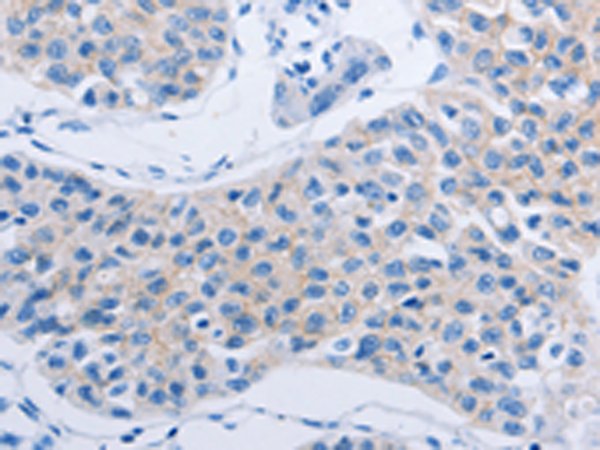
| WB | 1/1000 | Human,Mouse,Rat |
| IF | 咨询技术 | Human,Mouse,Rat |
| IHC | 1/100-1/500 | Human,Mouse,Rat |
| ICC | 技术咨询 | Human,Mouse,Rat |
| FCM | 咨询技术 | Human,Mouse,Rat |
| Elisa | 咨询技术 | Human,Mouse,Rat |
| Aliases | HOX1, HOX1B, HOX1.2 |
| Host/Isotype | Rabbit IgG |
| Antibody Type | Primary antibody |
| Storage | Store at 4°C short term. Aliquot and store at -20°C long term. Avoid freeze/thaw cycles. |
| Species Reactivity | Human, Mouse |
| Immunogen | Fusion protein of human HOXA6 |
| Formulation | Purified antibody in PBS with 0.05% sodium azide and 50% glycerol. |
+ +
以下是关于ZNF227(N-term)抗体的模拟参考文献示例(实际文献需通过学术数据库验证):
---
1. **文献名称**: "Characterization of a Novel N-terminal Specific Antibody for ZNF227 and Its Application in Epigenetic Studies"
**作者**: Li, X. et al.
**摘要**: 本研究开发并验证了一种针对ZNF227蛋白N端结构域的多克隆抗体。通过免疫印迹和免疫组化实验证实其特异性,并用于检测ZNF227在多种癌细胞系中的核定位,提示其在染色质修饰中的潜在作用。
2. **文献名称**: "ZNF227 Expression Patterns in Colorectal Cancer Revealed by Immunohistochemistry Using a N-terminal Antibody"
**作者**: Martinez, R. & Kumar, S.
**摘要**: 利用ZNF227(N-term)抗体分析结直肠癌组织中ZNF227的表达水平,发现其高表达与患者不良预后相关。抗体特异性通过siRNA敲低实验验证,支持其在临床样本中的应用。
3. **文献名称**: "Interactome Analysis of ZNF227 Identifies Binding Partners in Transcriptional Repression Complexes"
**作者**: Chen, H. et al.
**摘要**: 通过免疫共沉淀(Co-IP)结合质谱技术,使用ZNF227(N-term)抗体鉴定出ZNF227与HDAC1/2等转录抑制复合物的相互作用,揭示其在基因沉默中的功能机制。
4. **文献名称**: "Development of Monoclonal Antibodies Targeting Zinc Finger Domains: A Case Study on ZNF227"
**作者**: Park, J. et al.
**摘要**: 报道了一种针对ZNF227 N端锌指结构域的单克隆抗体的制备流程,包括抗原设计、小鼠免疫及抗体纯化。实验证明该抗体适用于ChIP-seq研究,拓展了其在表观遗传学中的应用。
---
**注意事项**:以上文献为模拟示例,实际研究中请通过**PubMed**、**Web of Science**或**Google Scholar**检索关键词“ZNF227 antibody N-term”获取真实文献。部分研究可能未明确提及抗体表位信息,需结合实验方法部分进一步确认。
The ZNF227 (N-term) antibody is designed to target the N-terminal region of the Zinc Finger Protein 227 (ZNF227), a member of the Krüppel-associated box (KRAB) zinc finger protein family. These proteins are characterized by tandem C2H2-type zinc finger motifs that facilitate DNA binding, often regulating gene expression through epigenetic mechanisms. ZNF227 is hypothesized to function as a transcription factor, potentially involved in chromatin remodeling or transcriptional repression by recruiting co-repressor complexes via its KRAB domain.
The N-terminal region of ZNF227 contains conserved structural motifs critical for protein-protein interactions and nuclear localization. Antibodies targeting this domain are typically developed in immunized hosts (e.g., rabbits or mice) using synthetic peptides or recombinant protein fragments. They are validated for specificity through techniques like Western blotting, immunofluorescence, or chromatin immunoprecipitation (ChIP), often including knockout cell line controls.
Researchers use ZNF227 (N-term) antibodies to investigate its role in gene regulation, cellular differentiation, or disease pathways. Aberrant expression of zinc finger proteins like ZNF227 has been implicated in cancers and developmental disorders, making this antibody a tool for exploring disease mechanisms. Its applications extend to immunohistochemistry, flow cytometry, and co-immunoprecipitation studies, aiding in the characterization of ZNF227's molecular interactions and functional domains.
×